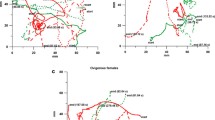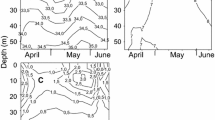Abstract.
The cubozoan medusa Tripedalia cystophora preys on dense swarms of the copepod Dioithona oculata in the mangrove prop-root habitat of Puerto Rico. The copepod swarms form in shafts of sunlight that penetrate the mangrove canopy during the day. T. cystophora are found primarily within the same illuminated areas, feeding heavily on the dense swarms of copepods. Laboratory studies were conducted to examine the behavioral adaptations of T. cystophora that allow them to remain within these dense copepod swarms. In the presence of vertical light shafts, T. cystophora showed both a significant change in swimming speed and a significant increase in turning rate. T. cystophora turn abruptly when they leave a vertical shaft of light and quickly re-enter. The presence or absence of copepod prey, either in swarms or dispersed, had no significant effect on T. cystophora swimming speed or turning behavior. Feeding rates of T. cystophora on the copepod D. oculata increase rapidly with copepod density, and maximum rates are not achieved until the high densities associated with swarms are reached. It seems doubtful that these small medusae could survive without their ability to encounter and exploit these dense swarms of copepods.
Similar content being viewed by others
Author information
Authors and Affiliations
Additional information
Electronic Publication
Rights and permissions
About this article
Cite this article
Buskey, .E. Behavioral adaptations of the cubozoan medusa Tripedalia cystophora for feeding on copepod (Dioithona oculata) swarms. Marine Biology 142, 225–232 (2003). https://doi.org/10.1007/s00227-002-0938-y
Received:
Accepted:
Issue Date:
DOI: https://doi.org/10.1007/s00227-002-0938-y




